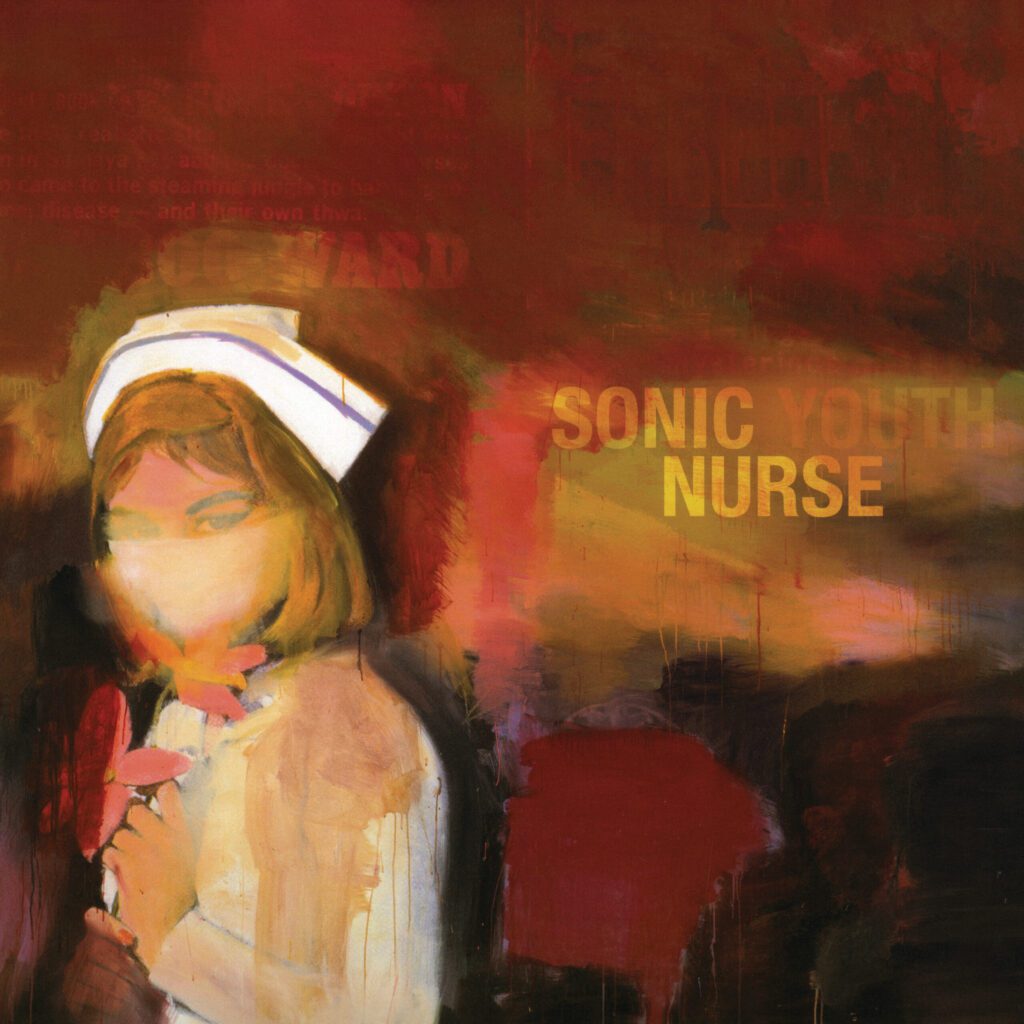
Joined on third guitar and occasional bass by new member Jim O’Rourke, then at the peak of his visibility thanks to his Drag City solo albums and his work for Wilco, Murray Street (2002) has a fetching thickness. The first three tracks, sung and written by Moore, don’t fuck around. “The Empty Page” and “Disconnection Notice” return to the terseness of the early Geffen period but complicated by years of experiments; you can see the first shoots of Sonic Nurse. It also has a gnomic intensity: the sort of album plausibly claimed as a favorite.
The best way to slide into Sonic Nurse is to sample “Stones,” a variant on the previous album’s “Rain On Tin.” No weird tunings, no crabbed movement: Moore and Ranaldo alternate between D and G chords while drummer Steve Shelley for a while keeps a beat that anyone can play. Pitched at a higher key than usual, Moore speaks of “warped lovers loose on languid stain” before the chorus takes a hairpin turn: “Dead or alive, there’s danger/ The dead are alright with me.” Long attracted to death because to do it in the mid ’80s countered cultural shibboleths of positivity, Sonic Youth now regarded it as an inevitability, not a kink.
Whether to accommodate terrors or fight them as middle-aged musicians animates the best of Sonic Nurse’s tracks. On “Paper Cup Exit” Ranaldo rails against “memory disease across the USA” and warns, “It’s later than you think.” On “Pattern Recognition,” over a shrieking guitar, Shelley’s nervous hi-hats, and nods towards William Gibson, Gordon yelps, “You’re the one!” and it’s not clear if it’s an endearment or a threat: Pitching her voice to compete with the bedlam is Gordon’s gift.
A provocateur whose feminist précises don’t abjure erotic play, Gordon likes to broach the limits of listenability; her tracks function as complements to Ranaldo’s Beat-damaged poetry and Moore’s Everyman curiosity. “I Love You, Golden Blue,” her greatest track of the ‘00s, starts with a feedback cloud illuminated by flashes of guitar peals, then settles into a loping groove over which Gordon, voice scraping the top of her range, laments the end of a relationship. The band, joined by O’Rourke, realizes its experiment in incremental gradation launched by “Hits Of Sunshine” six years earlier. Moreover, this is what dragging your knuckles against the stone wall of an infatuation sounds like (“I Love You, Golden Blue” made a couple of breakup CD-Rs I burned during this period).
But it’s Moore whose finale distinguishes Sonic Nurse’s historical moment. At once defiant and resigned, “Peace Attack” uses his birthday (Feb. 3) as the pivot around which he surveys America after 9-11. Thanks to the “crime boss” at the peak of his power, “springtime is wartime.” With its D-G-C chord progression Moore could be an antiwar strummer. But this is Sonic Youth. Ranaldo and O’Rourke’s guitars intertwine for leisurely solos with the sinuosity of Tom Verlaine and Richard Lloyd. Beauty in a dunghill — the Sonic Youth ethos.
Refreshed, the band released the excellent Rather Ripped two years later. The hooks were sharper, each singer-lyricist’s turf more defined, but the foursome’s belief in the semiotics and the symbiotics of a band wavered not a millimeter through 2009’s swan song The Eternal. Years later the world learned how Thurston Moore could be as banal as the guy in the office cubicle next to you. Believers in the Sonic Youth mythos will stan for Sister and Daydream Nation, I don’t care. To prefer the 1998-2006 era is no more venial than preferring Miles Davis’ 1964-1968 era or Madonna’s 1992-2000 era. Inspiration still refreshed craft. Sonic Nurse is the proof.



